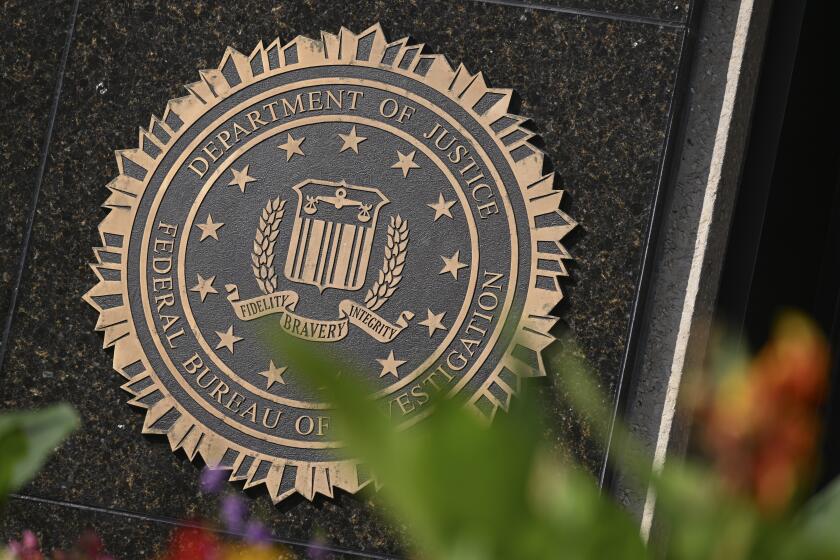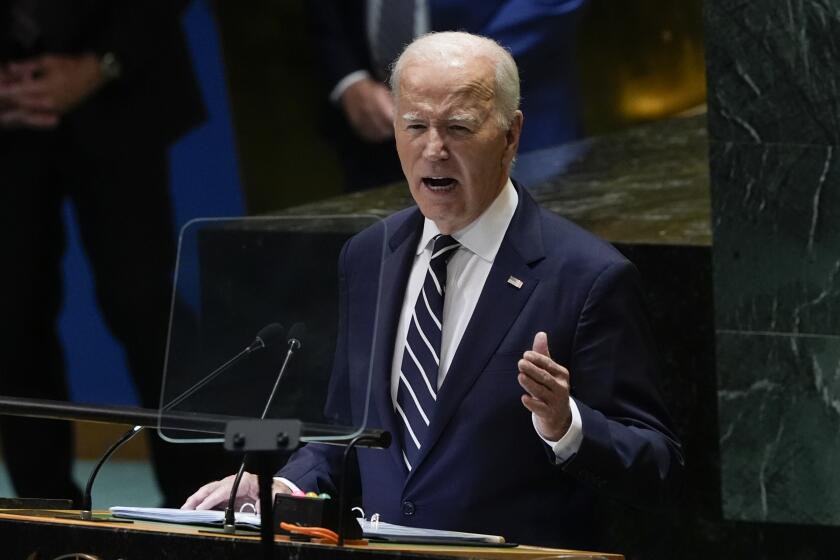Who gives money to Bernie Sanders? About $1 in every $4 came from people who aren’t working
Small-dollar contributions have been the fuel that has propelled Sen. Bernie Sanders’ presidential bid, making it one of the most successful insurgent campaigns in Democratic Party history, but little has been known about those donors because campaigns don’t have to publicize the names of people who give $200 or less.
Now, a Times analysis of nearly 7 million individual contributions has provided unprecedented detail about the army of people behind the $27 donations Sanders mentions at virtually every campaign stop.
Many resemble Emily Condit, 40 of Sylmar, who has contributed three times — $5 each — to the Vermont senator’s campaign.
Condit, who has several physical disabilities, is among the largest single group of Sanders’ donors — those who don’t have a job. Of the $209 million given to the Vermont senator’s campaign, about one out of every four dollars came from those not in the workforce, who include the unemployed or retired.
For the last 15 years, since Condit left a job at NASA, her ailments have kept her from working. She depends on Social Security and lives on a tight budget but has found money for Sanders because she was drawn to his populist message.
“I know very well now what it’s like to be a have-not, both financially and physically, and to fall through the cracks of society,” she said. “Bernie Sanders is running on a platform to lift up the have-nots and to improve the system of government we have, so that no one will ever be left behind.”
Small-dollar donors such as Condit have allowed Sanders to out-raise his rival, former Secretary of State Hillary Clinton, in the Democratic primary. Clinton had received $190 million through the end of April. (A separate super PAC backing her bid raised an additional $76 million.)
Bernie Sanders is running on a platform to lift up the have-nots and to improve the system of government we have, so that no one will ever be left behind.
— Emily Condit, 40
Californians contributed more than $36 million to Sanders’ campaign, the most money from any state in the nation, according to financial disclosure reports that cover fundraising through the end of April, the most recent available. Sanders has raised the majority of his money here in wealthy, coastal areas that are predominately white. Nine of the top 10 ZIP Codes with the highest rate of giving are north of San Jose, with concentrations in the Berkeley Hills and in scenic enclaves north of the Golden Gate Bridge.
In Los Angeles, Sanders received some of his strongest financial support per person from neighborhoods such as Topanga, Century City, Venice and the Hollywood Hills.
Adjusting for population, Sanders got the most donations from his home state of Vermont and Washington, D.C., where he has served in the Senate and House of Representatives for a quarter century. If the nine-county San Francisco Bay Area were its own state, it would rank third on that list.
The analysis of Sanders’ donations is possible because he relies on a fundraising tool called ActBlue, required by federal law to disclose all donors, regardless of the size of the contribution.
The Times combined federal reports from ActBlue and Sanders’ campaign to conduct an unprecedented analysis of Sanders’ contributors, including identifying people who had given multiple times.
This provided a window into the more than 1 million small-dollar contributors who gave nearly two-thirds of his money. These donors are typically invisible because election law only requires campaigns to disclose the identities of people who contribute more than $200.
The only contributors this analysis does not cover are small-dollar donors who gave directly to Sanders’ campaign committee. They accounted for about 10% of his donations.
Clinton is less reliant on small-dollar donors, who accounted for about 20% of her fundraising haul, and a similar analysis of the Democratic front-runner’s small donors is not possible because she has not leaned upon a conduit such as ActBlue.
Sanders donors tend to live in the most liberal parts of the United States — New England, the Pacific Northwest and California — and in the ZIP Codes with a high proportion of college graduates. With the exception of urban areas such as Austin, Texas; and Santa Fe, N.M.; he draws far fewer donations in the redder parts of the nation — the South, the Sunbelt and the Midwest.
After the jobless, people who work in the healthcare, education and technology fields are the next largest sources of Sanders’ funds.
“I just feel he’s honest, he’s straightforward, dependable, trustworthy and doesn’t change his tune to get votes,” said Connie Whalley, a nurse practitioner who left her job three years ago to spend more time with her family.
The 66-year-old Topanga resident has contributed $622 to Sanders’ campaign in 22 separate donations because she was impressed by his calls for a $15 minimum wage, tuition-free public college, campaign-finance reform and most of all, single-payer healthcare.
“I honestly believe everyone has the right to free healthcare and… I just think it is unspeakable we have insurance companies that are making profits off people’s health,” she said.
Not surprisingly, Sanders gets very little money — 2% of his overall haul — from Wall Street, which he frequently criticizes as “corrupt” and responsible for creating a “rigged economy.” Students, who are vocal Sanders supporters, gave even less.
Sanders constantly touts that the average donation to his campaign is $27, a line he’s repeated so often that supporters shout out the dollar amount at his rallies.
The figure is accurate and once it became a symbol of Sanders’ bid, the campaign provided a $27 donation button on its website. About 10% of his donations are for that amount.
Because Sanders’ backers tend to donate multiple times, the average donor gave a total of $96. His typical donor contributes three times, but loyal cohorts tap their bank accounts far more frequently, in part because the campaign’s fundraising system encourages supporters to set up weekly or monthly automated contributions.
Other donors, such as Connie Kazmer of Granada Hills, said they went on spending sprees any time they felt moved by the campaign. The 60-year-old sound editor said she watched every Democratic debate with her laptop open, ready to give when something riled her.
Over the course of nine debates, Kazmer donated more than 100 times, topping $2,200 in contributions.
“I had to pace myself,” Kazmer said.
Jeremy Abramowitz, a recent graduate from the College of William and Mary in Virginia, gave Sanders’ campaign more than $5,000 in more than 200 separate donations.
Abramowitz, 31, started sending money after reading negative posts about Sanders on Facebook. He soon lost track of how much he was giving.
“When somebody said something that annoyed me, I’d give an extra dollar,” said the Williamsburg, Va., resident. “It all just added up.”
After Abramowitz hit the legal limit on what he could give the campaign — $5,400 — he channeled his energy into volunteering for Sanders at a phone bank. He averages 1,000 calls a day, he said.
Times staff writer Sandra Poindexter contributed to this report.
ALSO
Clinton says Trump’s foreign policy agenda is ‘dangerously incoherent’
How much does Hillary Clinton want to win California? She and Bill have over 30 events in 5 days
For the latest on national and California politics, follow @LATSeema on Twitter.
More to Read
Get the L.A. Times Politics newsletter
Deeply reported insights into legislation, politics and policy from Sacramento, Washington and beyond. In your inbox three times per week.
You may occasionally receive promotional content from the Los Angeles Times.













